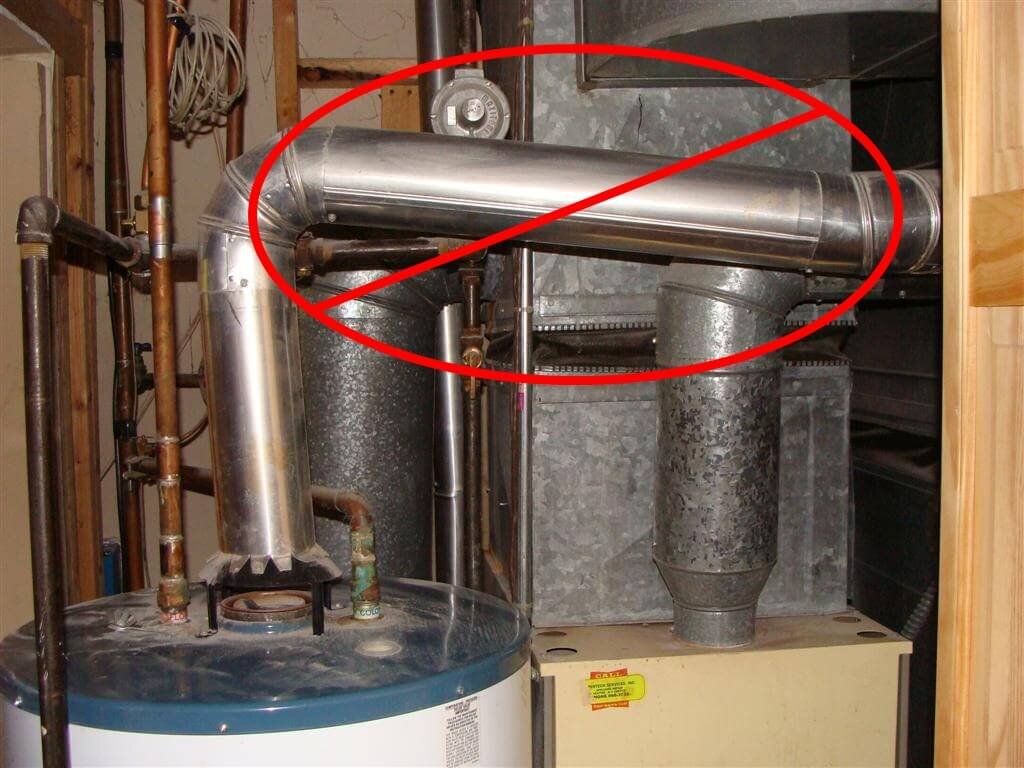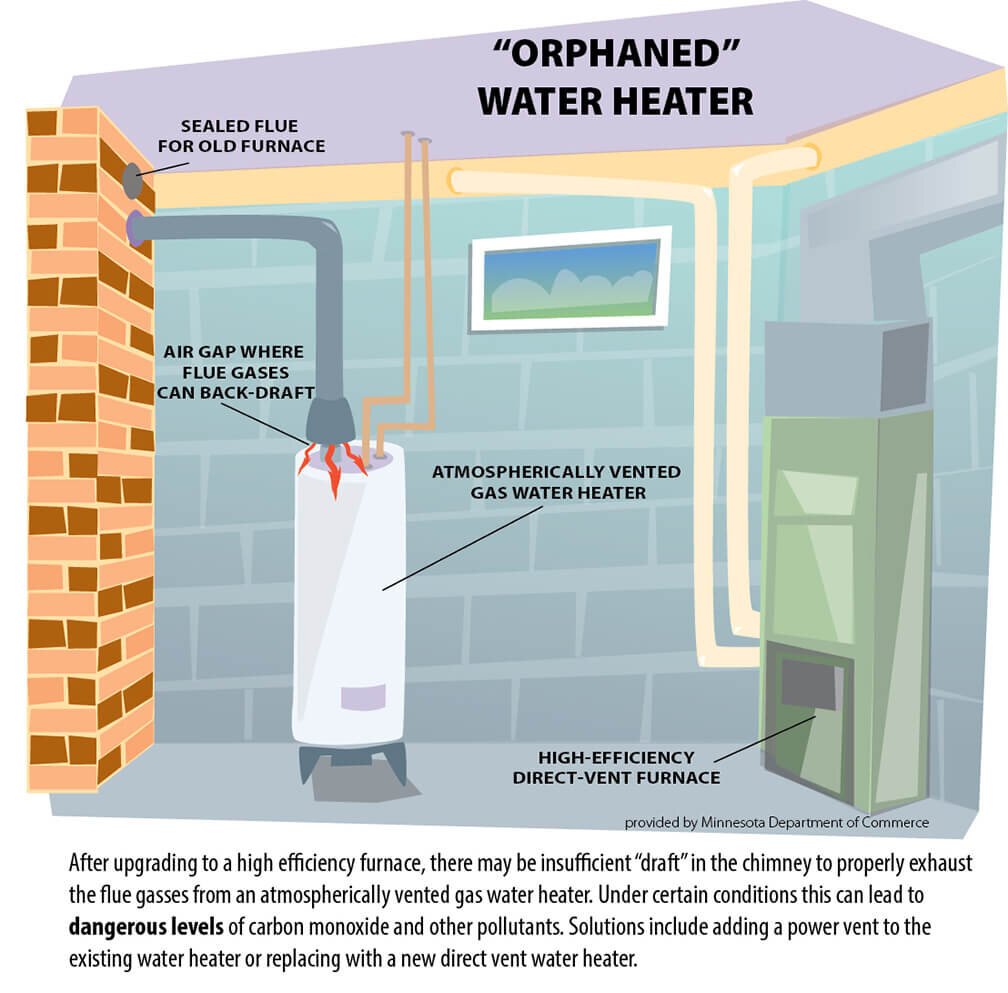Inspecting a natural draft water heater vent happens quickly and easily once you know what to look for. Today, I’ll show you what to look for when looking at a water heater vent connector. I recently blogged about inspecting water heaters and testing for proper draft at water heaters, and I just couldn’t squeeze the part about inspecting water heater vents into those posts. This is really a topic all on its own, so here goes.
DEFINITIONS
To start, I need to define exactly what this blog post is about: inspecting a natural draft water heater vent connector. If you’re inspecting the vent on a powervent water heater, read the friendly manual (RTFM) and make sure someone followed the manufacturer’s installation instructions. The installation manual will tell you everything you need to know; what material is acceptable, what size vent is needed, how long of a run is allowable, where it’s supposed to terminate, all that jazz. The most common error we find with powervent water heaters is improper terminals.
As for natural draft water heaters, it’s important to distinguish between the vent and the vent connector. The vent is the metal thing that goes from the room that the water heater is in and rises up through the roof. It’ll typically be a straight vertical run of UL-listed double-wall class-B vent. The vent connector is the thing that connects the water heater to the vent. It usually runs more horizontally than it does vertically. It’s important to know the difference between these two because the installation rules aren’t the same.

LENGTH AND WIDTH
It used to be standard practice for water heaters to use a 3″ vent connector, but today all that’s allowed is a 4″ vent connector or larger. For residential installations, it’s very unusual to have anything other than a 4″ vent connector.
As for vent connector length, this is a tough one to figure out. In general, the shorter the better. The longer the run on a vent connector, the greater the potential for backdrafting. The image above would depict a more ideal installation if the water heater were installed closer to the vent, but still, it’s not bad.
National fuel gas codes allow the vent connector to have 1-1/2′ of horizontal run for every inch of vent connector diameter. In other words, a 4-inch vent connector would be allowed to have a 6-foot horizontal run. There are exceptions that allow for longer runs, but this is a good guideline to follow.

When a water heater vent connector is over six feet long, it’s probably an improper installation that might not draft properly. Sometimes it’ll still work just fine, however, and that’s why testing for proper draft and looking for signs of previous backdrafting is important. Check out my previous blog post on how to test the draft at a water heater for more info on that topic.
PITCH
Water heater vent connectors need to pitch upward at a minimum of 1/4″ per foot. Ideally, much more than this. When water heater vents aren’t pitched properly, they have a greater potential to backdraft.


The image below, courtesy of Dr. Seuss, shows a comically bad installation of a water heater vent connector.

While that corrugated stuff shown above is surely not meant for a water heater, there’s a very similar version of it that’s legal to use. It’s a listed flexible appliance vent connector, and it comes in varying lengths and sizes. This stuff is fine.

CLEARANCES
Gas vents get hot, and they need to maintain enough clearance to combustible materials to help prevent damage. For the record, everything is combustible unless it’s defined as noncombustible. This includes items such as wood, as well as the paper face on drywall. For single-wall vent connectors, there needs to be 6″ of clearance to anything that’s combustible. These required clearances can be reduced by installing shields in accordance with section 308 of the Minnesota Fuel Gas Code.
The image below shows a nice example of scorched drywall paper from a single-wall furnace vent connector that was too close.

I don’t have any similar images of scorching caused by an improper water heater vent connector, frankly, because I’ve never seen it happen. From a home inspection perspective, when I find improper clearance to combustibles at a water heater vent, it’s not a big deal. It’s usually an installation that has been that way for many years, there are no signs of past problems, and there will surely be no problems in the future. I still report on this, however, because it’s the kind of thing that will usually need to be fixed when the appliance is replaced, and I don’t want my clients to be surprised.
The other common type of vent connector is a double-wall vent connector. These are also known as B-vents, and you simply follow the instructions from the manufacturer. Almost all B-vents require 1″ clearance to combustibles, but not always. You have to go with whatever the manufacturer tells you. B-vents come with a label indicating the minimum clearance required.
ORPHANED WATER HEATER
When a water heater shares a vent with a larger appliance, such as a furnace, you’ll typically have a larger 6″ or 7″ vent to accommodate all of that heat. This works fine during the winter when the furnace can heat up the vent and keep it warm most of the time. If the furnace is replaced with a high-efficiency furnace, it’ll no longer use that same vent, and will instead vent out through the side of the building with a PVC vent. When that happens, the lonely water heater is now left with a huge vent that it probably won’t be able to keep warm all by itself.
The illustration below, provided by the Minnesota Department of Commerce, Division of Energy Resources, shows what this looks like.

The relatively small burner on the water heater may not generate enough heat to warm up the chimney or vent, which can lead to backdrafting. This can also lead to excessive condensation inside the vent, which can cause the vent to rust out. In many cases, a new vent liner will be installed to allow the water heater to vent into a smaller space.
The text in the image above also mentions adding a power vent to the existing water heater. Tjernlund of White Bear Lake, MN makes such devices; one is a powervent conversion kit for an existing water heater, and another is a chimney stack assist kit for an existing water heater.
ARRANGEMENT
When a water heater shares a vent with another appliance, the largest appliance needs to be at the bottom of the vent stack. This is to help promote proper draft for the smaller appliance, which is typically the water heater.
Also. if a water heater shares a vent with a draft-assisted furnace, the vent connector needs to be arranged so that the furnace’s vent fan doesn’t cause the water heater to backdraft. The two vent connectors can’t sit across from each other, or the water heater will backdraft every time the furnace runs at the same time.

Last but not least, single-wall vent connectors need to have three screws per joint to help prevent stuff from coming loose.


